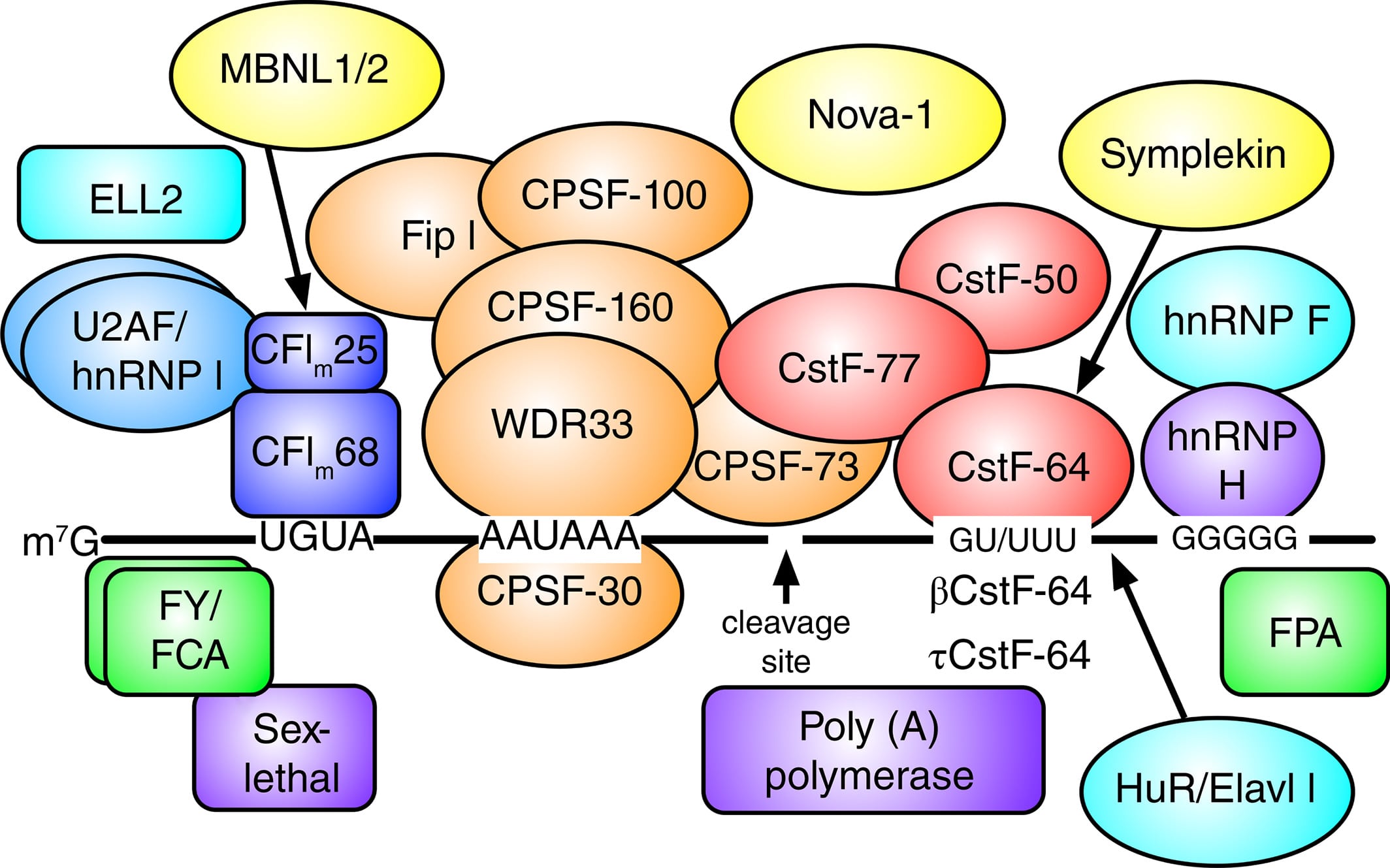
Polyadenylation is a fascinating process in molecular biology that plays a crucial role in the maturation and stability of messenger RNA (mRNA). This process involves the addition of a string of adenine nucleotides, known as the poly(A) tail, to the 3′ end of the mRNA molecule. While polyadenylation may seem like a simple biochemical modification, it has far-reaching implications for gene expression and cellular function.
In this article, we will delve into the incredible world of polyadenylation and uncover 17 unbelievable facts about this essential process. From its discovery to its diverse functions, we will explore the intricate mechanisms and fascinating phenomena associated with polyadenylation. So, buckle up and get ready for a mind-blowing journey into the world of molecular biology!
Key Takeaways:
- Polyadenylation is like adding a protective shield to mRNA, making it last longer and helping it get translated into proteins more efficiently. It’s like giving a superhero extra armor for a tough battle!
- Polyadenylation is crucial for our cells to work properly and stay healthy. It’s involved in everything from controlling gene expression to fighting off viruses, showing how important it is for our bodies to function.
Polyadenylation: The Final Touch
Polyadenylation is a crucial process in gene expression that involves the addition of a string of adenine nucleotides, known as a poly(A) tail, to the end of an mRNA molecule. This modification plays a vital role in regulating RNA stability, translation efficiency, and nuclear export.
A Multi-Step Process
Polyadenylation occurs in multiple steps, starting with the recognition of specific sequences, known as polyadenylation signals, in the pre-mRNA molecule. This triggers the assembly of the polyadenylation complex, which includes proteins responsible for cleaving the RNA and adding the poly(A) tail.
Beyond mRNA Stabilization
While polyadenylation is primarily known for its role in mRNA stabilization, recent research has revealed its involvement in other essential cellular processes. It has been linked to alternative splicing regulation, nuclear mRNA export, and even microRNA biogenesis.
RNA Stability Control
The addition of a poly(A) tail provides protection against degradation by exonucleases, extending the lifespan of the mRNA molecule. The length of the poly(A) tail influences the stability of the mRNA, with longer tails generally associated with increased stability.
Dynamic Poly(A) Tail Length
Contrary to popular belief, poly(A) tail length is not a fixed characteristic. It can vary extensively, and this dynamic regulation is crucial for controlling gene expression in response to different cellular conditions, such as stress or developmental cues.
Enhancing Translation Efficiency
Polyadenylation plays a crucial role in promoting efficient translation of mRNA into proteins. The poly(A) tail interacts with various translation factors, facilitating the initiation and ribosome binding to the mRNA molecule.
Alternative Polyadenylation
In addition to the canonical cleavage and polyadenylation site, alternative polyadenylation generates multiple mRNA isoforms from a single gene. This process allows for the production of distinct protein variants, expanding the functional diversity of the proteome.
Regulation by cis-acting Elements
Regulation of polyadenylation is mediated by cis-acting elements located in the pre-mRNA sequence. These elements interact with specific polyadenylation factors to determine the site of cleavage and the length of the poly(A) tail.
The Polyadenylation Signal
The polyadenylation signal sequence, also known as the AAUAAA motif, is the most common recognition element for the polyadenylation process. However, alternative polyadenylation signals have also been identified, expanding the complexity of polyadenylation regulation.
Polyadenylation and Disease
Aberrant polyadenylation has been implicated in various diseases, including cancer, neurodegenerative disorders, and genetic syndromes. Dysregulation of polyadenylation can disrupt normal gene expression patterns and contribute to disease progression.
Polyadenylation Machinery
The polyadenylation process involves a complex machinery consisting of polyadenylation factors, RNA-binding proteins, and enzymes responsible for RNA cleavage and poly(A) tail addition. Alterations in the expression or activity of these components can impact polyadenylation efficiency.
Polyadenylation and mRNA Localization
Polyadenylation has a role in determining the subcellular localization of mRNA molecules. The poly(A) tail interacts with proteins involved in mRNA localization and guides the transcript to specific cellular compartments, such as dendrites in neurons.
Polyadenylation in Development
Polyadenylation plays a critical role in embryonic development and tissue-specific gene expression. Proper regulation of polyadenylation is essential for generating the necessary mRNA isoforms required for distinct cellular functions.
Cross-Talk with Transcription
The polyadenylation process is tightly connected with transcriptional regulation. Factors involved in transcription elongation and termination can influence polyadenylation efficiency, adding another layer of complexity to gene expression control.
Polyadenylation in Viral Infection
Viral infections often manipulate the host polyadenylation machinery to favor viral gene expression. Viruses may encode proteins that interact with polyadenylation factors, altering the processing of mRNA and facilitating viral replication.
Role in RNA Decay
Polyadenylation also participates in mRNA decay pathways. Shortening of the poly(A) tail can trigger mRNA degradation, allowing for the removal of unwanted or damaged transcripts from the cellular pool.
Evolutionary Conservation
Polyadenylation is a highly conserved process, found in all known eukaryotic organisms. This conservation highlights its fundamental importance in gene expression and suggests its crucial role throughout evolution.
These 17 unbelievable facts about polyadenylation shed light on the incredible complexity and significance of this essential biological process. From mRNA stability control to translation efficiency and disease association, polyadenylation plays a vital role in gene expression regulation. Understanding its intricacies can unveil new avenues for research and potential therapeutic interventions.
Conclusion
Polyadenylation is a fascinating biological process with myriad functions and implications. From its role in gene regulation to its involvement in mRNA stability and translation, polyadenylation is a vital player in the intricate machinery of molecular biology. These 17 unbelievable facts about polyadenylation shed light on its importance and complexity.
Understanding polyadenylation not only deepens our knowledge of gene expression but also has significant implications in various fields, including medicine and biotechnology. Studying this process can help researchers develop innovative ways to manipulate gene expression for therapeutic purposes, such as developing targeted therapies for diseases like cancer.
As science continues to unravel the mysteries of polyadenylation, it paves the way for exciting advancements in biology and medical research. By delving into the intricate details of polyadenylation, scientists are uncovering the building blocks of life itself.
FAQs
1. What is polyadenylation?
Polyadenylation is a process in molecular biology where a long chain of adenine nucleotides (poly A tail) is added to the 3′ end of a messenger RNA (mRNA) molecule.
2. What is the function of polyadenylation?
Polyadenylation plays a crucial role in mRNA stability, nuclear export, and translation. It also influences gene expression by regulating the interaction of mRNA with various cellular processes.
3. How does polyadenylation affect gene expression?
Polyadenylation can affect gene expression by determining the stability, localization, and translatability of mRNA. It can also influence alternative splicing and the production of different protein isoforms.
4. Are all mRNA molecules polyadenylated?
While most mRNA molecules undergo polyadenylation, some exceptions exist. For example, certain viral RNAs lack a poly(A) tail, and some non-coding RNAs do not undergo polyadenylation.
5. Can polyadenylation be regulated?
Yes, polyadenylation can be regulated by various factors, including sequence elements within the mRNA molecule and RNA-binding proteins. These regulatory mechanisms allow for precise control of gene expression.
6. What are the implications of studying polyadenylation?
Studying polyadenylation can provide insights into the mechanisms of gene expression and help develop targeted therapies for diseases. It can also contribute to our understanding of evolution and the diversity of gene expression patterns.
7. Are there any diseases associated with abnormalities in polyadenylation?
Yes, abnormalities in polyadenylation have been linked to several diseases, including cancer, neurological disorders, and genetic syndromes. Understanding these abnormalities can aid in the development of diagnostic tools and potential treatments.
8. How is polyadenylation studied in the laboratory?
Scientists use various techniques to study polyadenylation, including RNA sequencing, reverse transcription-polymerase chain reaction (RT-PCR), and biochemical assays. These methods allow researchers to examine polyadenylation patterns and regulatory factors.
Polyadenylation's fascinating facts leave you craving more captivating insights into life's building blocks. Dive into the wonders of gene expression, where nature's code comes alive. Molecular biology holds astonishing secrets waiting to be discovered. Explore the intricate dance of mRNA splicing, a crucial step in creating life's diversity. Embark on a journey through the remarkable world of genetics and uncover the extraordinary mechanisms that shape our existence.
Was this page helpful?
Our commitment to delivering trustworthy and engaging content is at the heart of what we do. Each fact on our site is contributed by real users like you, bringing a wealth of diverse insights and information. To ensure the highest standards of accuracy and reliability, our dedicated editors meticulously review each submission. This process guarantees that the facts we share are not only fascinating but also credible. Trust in our commitment to quality and authenticity as you explore and learn with us.


